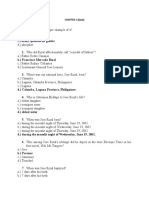UNIT 1
What is Communication:
Communication is the process of exchanging information, ideas, thoughts, or
feelings between two or more people.
It happens through words (verbal), gestures, expressions, body language, or
symbols (non-verbal), and even through technology like phone calls, messages,
or emails.
In one line:
Communication means sharing and understanding messages.
Key Points:
1. Sender – the person who gives the message.
2. Message – the information, idea, or feeling being shared.
3. Medium/Channel – how the message is sent (speech, writing, gesture,
internet, etc.).
4. Receiver – the person who gets the message.
5. Feedback – the response from the receiver (shows if the message is
understood).
Example:
A teacher explaining a lesson → students listening → students asking doubts →
teacher answering. This is communication.
Understanding the Communicative Environment – I
Meaning
Communication is never in isolation; it always happens within a
surrounding environment that shapes how people send, receive, and
interpret messages.
This environment includes who is communicating (participants), what
is being communicated (message), how it is sent (channel), how it is
responded to (feedback), and what obstacles occur (barriers).
Key Elements:
1. Sender & Receiver
o Sender: The person who starts the communication by encoding a
message.
o Receiver: The person who decodes (interprets) the message.
o Communication is effective only if the receiver understands the
message as intended.
Example:
o In a doctor-patient interaction, the doctor (sender) explains
medication dosage, and the patient (receiver) listens carefully.
o If the patient misunderstands and takes the wrong dose, the
communication fails.
2. Message
o The core content of communication: ideas, information, emotions,
or instructions.
o Messages can be verbal (spoken/written) or non-verbal (gestures,
expressions, tone, posture).
Example:
o A manager saying, “Great job on the report” (verbal) while
smiling (non-verbal).
o If the words are positive but tone is sarcastic, the message can be
misunderstood.
3. Channel
o The medium through which the message is sent.
o Examples: face-to-face conversation, phone call, email, video
conference, WhatsApp, or even gestures.
o The choice of channel affects clarity, speed, and emotional impact.
Example:
o If a friend apologizes via text, it may feel less sincere than
apologizing face-to-face with genuine tone and body language.
4. Feedback
o The response given by the receiver to the sender.
o Confirms whether the message was received and understood
correctly.
o Feedback can be verbal (“Yes, I understood”) or non-verbal
(nodding, smiling, confused look).
Example:
o A teacher asks, “Do you understand this concept?”
o Students nodding or asking follow-up questions act as feedback.
5. Barriers (Noise/Obstacles):
Barriers to a Communicative Environment
Meaning
Barriers to a communicative environment are the problems or obstacles that
stop people from exchanging messages clearly. These barriers disturb
understanding and can create confusion or misunderstanding.
Main Barriers with Examples
1. Physical Barriers
o Problems in the physical surroundings that block communication.
o Examples: Noise in a classroom, poor telephone connection, or
sitting far away from the speaker.
2. Language Barriers
o When people do not share a common language or use
difficult/unclear words.
o Examples: A doctor using medical terms that a patient cannot
understand, or two people speaking different languages.
3. Psychological Barriers
o Mental state or attitude of people that affects communication.
o Examples: A student too nervous to ask a question in class, or
someone not listening because of anger or stress.
4. Cultural Barriers
o Differences in traditions, values, and customs that affect
communication.
o Examples: In some cultures direct eye contact shows confidence,
but in others it may seem disrespectful.
5. Organizational Barriers
o Problems that happen in workplaces or institutions due to rules,
hierarchy, or structure.
o Examples: A message taking too long to reach the boss because it
passes through many levels of employees.
6. Perceptual Barriers
o When people see or interpret the same message differently.
o Examples: A manager’s strict tone may be seen as motivating by
one employee but as rude by another.
Barriers to a communicative environment block the smooth flow of messages
and create misunderstandings. By reducing noise, using simple language, being
culturally sensitive, and listening carefully, these barriers can be overcome,
leading to effective communication.
Example:
o During an online class, poor internet connection (physical barrier)
makes the lecture unclear.
o If the teacher uses only technical jargon, students may not grasp it
(language barrier).
1. Workplace Example
o Sender: Project manager assigns a task through email.
o Message: “Submit the report by Friday, 5 PM.”
o Channel: Email.
o Receiver: Team member.
o Feedback: Team member replies, “Noted, I will complete it.”
o Barrier: If the email goes to the spam folder or the manager writes
vaguely (“submit soon”), miscommunication happens.
2. Family Example
o Sender: Parent tells child, “Don’t stay out late.”
o Message: Concern for safety.
o Channel: Face-to-face talk.
o Receiver: Child.
o Feedback: Child nods but rolls eyes (non-verbal).
o Barrier: Generation gap parent sees it as safety; child sees it as
restriction.
3. Cultural Example
o In Japan, silence during conversation can mean respect and
thoughtfulness.
o In Western cultures, silence may feel awkward or rude.
o Same message, but cultural environment changes interpretation.
Understanding the Communicative Environment – II
Meaning
Communication does not happen in a vacuum. It always takes place
within different types of environments that influence how messages are
created, delivered, and understood.
These environments can be physical, social, cultural, technological, and
psychological.
Types of Environments
1. Physical Environment
Refers to the actual location or setting where communication occurs.
It includes place, space, lighting, noise, seating arrangement, and
distance.
A comfortable, quiet, and organized physical setting enhances
communication, while a noisy or chaotic setting hinders it.
Example:
In a classroom, students sitting too far from the teacher may not hear
properly.
In a conference room, poor lighting and uncomfortable seating can
distract participants from focusing on the discussion.
2. Social Environment
Refers to relationships, roles, and group dynamics among participants.
Includes hierarchy (boss–employee, teacher–student), friendships,
teamwork, and power structures.
The nature of relationships determines the tone, level of formality, and
openness of communication.
Example:
In a workplace, an employee may speak formally to their manager but
informally with a colleague.
In a family setting, communication is usually more casual, emotional, and
supportive compared to professional spaces.
3. Cultural Environment
Refers to the values, beliefs, customs, and traditions that shape
communication.
Cultural background influences language choice, gestures, body
language, politeness norms, and meaning of silence.
Miscommunication often happens when people from different cultures
interpret the same message differently.
Example:
In Western culture, maintaining eye contact shows confidence.
In some Asian cultures, too much eye contact may be seen as
disrespectful.
A hand gesture like a “thumbs up” is positive in the US, but offensive in
some Middle Eastern countries.
4. Technological Environment
Refers to the digital and technical tools used in communication.
Includes email, social media, Zoom/Teams meetings, WhatsApp, AI
chatbots, etc.
Technology makes communication faster and borderless but can also
cause misinterpretations if not used carefully.
Example:
In an online class (Zoom), the teacher shares slides and students interact
in the chat box.
If the internet connection is poor or students don’t know how to use the
“raise hand” feature, effective communication is hindered.
Emojis in WhatsApp can express emotions, but overuse may create
confusion.
5. Psychological Environment
Refers to the mental and emotional state of communicators.
Attitudes, motivation, stress, prejudices, trust, and confidence all play a
big role.
Even in the same setting, communication outcomes differ depending on
the psychological climate.
Example:
If a student feels anxious before giving a presentation, their nervous tone
may affect clarity.
If a manager is in a bad mood, they may interpret a neutral question as
criticism.
On the other hand, a positive and supportive environment builds openness
and confidence.
Combined Example
Imagine an online team meeting:
Physical environment: Each member is sitting at home, in different
surroundings.
Social environment: A manager leads the discussion, and team members
follow.
Cultural environment: Members from different countries may have
varying expectations about directness or politeness.
Technological environment: Meeting is on Zoom, using chat, video, and
shared screen.
Psychological environment: One team member is motivated, another is
stressed, which affects participation.
The effectiveness of communication depends on how well these environments
are understood and managed.
Importance of Communicative Environment
A positive environment like friendly, open, and respectful helps people
express themselves freely and clearly.
A negative environment like fear, confusion, or lack of respect causes
misunderstandings and weak communication.
Thus, the communicative environment is the complete background in which
communication happens. It decides whether communication will be successful
or unsuccessful. With the right environment, communication becomes clear,
respectful, and meaningful.
Example (to remember easily):
Think of communication like planting a seed. The seed is the message, but
whether it grows well or not depends on the soil, water, and sunlight this is the
communicative environment.
What to Listen For and Why
Key Indicators of What to Listen For
Listening is not just about hearing words. Good listeners pay attention to
different signs or indicators in communication to fully understand the message.
The five key indicators are explained below:
1. Main Ideas
The most important part of listening is to find out the central theme or
main message of what the speaker wants to say.
Many times, speakers give examples or stories, but the listener must
identify the main idea hidden behind them.
Example:
In a company meeting, a manager may talk for 10 minutes, but the main
idea might be: “We need to increase sales this month.”
If a listener misses the main idea, they may misunderstand the whole
purpose of communication.
2. Facts and Supporting Details
After catching the main idea, listeners must also notice facts, figures,
examples, and evidence that support the message.
These details add clarity and help in making better decisions.
Example:
Main Idea: Teacher says “Regular study improves exam results.”
Supporting Details: Students who revise daily remember lessons better
and those who make notes score higher in tests.
Without paying attention to details, listeners will not have full knowledge
of the subject.
3. Tone and Emotions of the Speaker
Communication is not only about words; it also carries emotions.
Listeners must notice whether the speaker sounds happy, sad, angry, or
worried.
The tone often shows the true meaning behind the message.
Example:
A boss may say, “This work should be finished soon.” If said in a soft
tone, it is a suggestion; if said in a harsh tone, it becomes a strict order.
Ignoring tone and emotions may cause misunderstanding.
4. Non-Verbal Cues (Body Language)
A large part of communication happens without words through gestures,
posture, and facial expressions.
Good listeners must pay attention to these non-verbal signals.
Example:
A colleague saying, “I am okay,” while avoiding eye contact or looking
upset, clearly means they are not okay.
Non-verbal cues help listeners understand the real feelings of the speaker.
5. Hidden or Implied Meaning
Sometimes the message is not spoken directly but is hidden between the
lines. Listeners must use their thinking to understand what the speaker
really means.
Example:
If an employee says, “This project is taking a lot of time,” the hidden
meaning may be: “I need more help” or “We need better planning.”
By catching implied meaning, listeners can respond more effectively.
Good listening means not just hearing words but also understanding the main
idea, supporting details, tone, non-verbal cues, and hidden meanings. These five
indicators help people understand messages fully, reduce misunderstandings,
and make communication more effective in personal as well as professional life.
6. Facts & Information
o The core message or content being shared.
o Focus on details like dates, numbers, instructions, or key ideas.
Example for Students:
o In a lecture, if the teacher says: “Your assignment is due on
Monday by 5 PM”, listening to the fact (deadline) is crucial.
o If you only hear “assignment” but miss “Monday by 5 PM,” you
risk losing marks.
7. Emotions & Feelings
o The tone of voice and choice of words often reveal feelings (anger,
excitement, stress, joy).
o Recognizing emotions helps you respond sensitively.
Example:
o A friend says: “I’m fine” but sounds upset and avoids eye contact.
o By listening beyond the words, you realize they are not fine and
may need comfort.
8.Intentions
o The purpose behind the message is the person seeking help, giving
instructions, sharing information, or expressing frustration?
o Understanding intention prevents misinterpretation.
Example:
o A classmate says: “This topic is so difficult.”
o If you only hear the complaint, you may ignore it.
o If you listen to the intention, you realize they might want group
study or your notes.
9.Non-verbal Cues
o Communication is not just about words; body language, gestures,
facial expressions, and posture also “speak.”
o Non-verbal cues can confirm or contradict the spoken words.
Example:
o During a presentation, a teacher may nod and smile showing
encouragement.
If the teacher looks confused, it signals you should explain again.
Example for Easy way to remember:
Listening is like watching a movie. The main idea is the story, details are the
scenes, tone is the background music, body language is the acting, and hidden
meaning is the moral of the story. Without all these, the story feels incomplete.
o
Why Listening Matters
Importance of Listening Skills in a Business Environment
Meaning
Listening skills mean the ability to pay full attention, understand, and respond
correctly to what others are saying. In a business environment, good listening is
very important for clear communication, teamwork, and decision-making.
Importance of Listening Skills
1. Better Understanding of Tasks
o Employees who listen carefully understand instructions correctly.
o Example: A worker who listens well to a manager’s directions
avoids mistakes in a project.
2. Building Good Relationships
o Listening shows respect and helps build trust between colleagues,
managers, and clients.
o Example: A manager who listens to employees problems creates a
friendly workplace.
3. Improves Teamwork
o Good listening helps team members share ideas and work together
smoothly.
o Example: In a business meeting, when everyone listens carefully,
decisions are taken faster.
4. Better Customer Service
o Listening to customers needs and complaints improves satisfaction.
o Example: A salesperson who listens carefully can suggest the right
product to a customer.
5. Helps in Conflict Resolution
o Listening calmly reduces arguments and helps find solutions.
o Example: Two employees in conflict can solve their issue if they
listen to each other’s point of view.
6. Encourages Innovation and Ideas
o When managers listen to employees, they get new and creative
suggestions.
o Example: Listening to staff feedback may lead to improving
company products.
7. Improves Leadership
o A good leader is also a good listener. Employees respect leaders
who listen to them.
o Example: A CEO who listens to employees feedback gains loyalty
and trust.
In a business environment, listening is just as important as speaking. It improves
understanding, teamwork, customer satisfaction, and leadership. Without
listening, communication becomes one-sided and ineffective.
Simple Example to Remember:
In business, speaking without listening is like selling without knowing what the
customer wants, it will not succeed.
Example:
In a group project meeting:
A teammate says: “I’m not sure I can finish my part before Friday.”
If you only hear the words, you think: “Okay, he can’t do it.”
But if you listen to the tone (tired voice), emotions (stress), and
intention (asking for help), you understand:
o They are overwhelmed and need support.
o The group can decide to share the workload or extend time.
By truly listening, you not only solve the issue but also build teamwork and
trust.
Starting a Conversation
a) Greetings
Example: “Hi, I’m Riya. Are you also in the economics class?”
Explanation:
o A greeting introduces yourself and sets a friendly tone.
o Asking if the other person is in the same class creates a common
ground.
o It shows openness without being intrusive.
b) Small Talk
Example: “This library is always so peaceful. Do you study here often?”
Explanation:
o Commenting on the environment makes it easy to start casually.
o Asking a follow-up question invites the other person to share,
which avoids awkward silence.
c) Open-Ended Questions
Example: “What part of today’s lecture did you find most useful?”
Explanation:
o Unlike a yes/no question, this requires a thoughtful response.
o It keeps the conversation flowing and allows deeper discussion
about studies.
d) Common Interests
Example: “I saw you at the cricket practice yesterday! Do you play for
the college team?”
Explanation:
o Referring to a shared experience builds connection instantly.
o It also gives the other person a chance to talk about something they
are passionate about.
2. Sustaining a Conversation
a) Active Listening
Example:
o Friend: “I’m finding this programming assignment really difficult.”
o You: “Yes, it’s tricky. I also struggled with the loops. Which part
are you stuck on?”
Explanation:
o You are not only agreeing but also encouraging them to explain
more.
o Shows genuine interest and keeps the conversation alive.
b) Showing Empathy
Example:
o Friend: “I didn’t do well in the presentation. I was so nervous.”
o You: “I know how that feels. I was also nervous during my first
one. You still managed well!”
Explanation:
o Acknowledging their feelings makes them feel understood.
o Encouragement builds trust and strengthens relationships.
c) Follow-up Questions
Example:
o Friend: “I joined the photography club this semester.”
o You: “That’s awesome! What kind of photos do you enjoy taking
the most?”
Explanation:
o Instead of stopping at “That’s awesome,” asking a follow-up
invites deeper sharing.
o It shifts the focus to their interest, which keeps them engaged.
d) Balancing Speaking & Listening
Example:
o Friend: “I went hiking last weekend.”
o You: “That’s exciting! I also went trekking last month to a
waterfall. It was a great experience.”
Explanation:
o You acknowledge their experience, then add your own.
o This way, the conversation remains two-way instead of one-sided.
3. Extended Student Scenarios
Scenario 1: In Class
Start: “Hey, did you understand the last topic on supply and demand?”
Sustain: “I also found it confusing, but I watched a YouTube video that
helped. Do you want the link?”
Explanation: Starts with a shared struggle, then offers help → builds
academic bonding.
Scenario 2: In the Library
Start: “Hi, do you usually come here to study? It’s quieter than the
canteen.”
Sustain: “Same here. I’m preparing for the maths exam. What about
you?”
Explanation: Begins with an observation (quiet library) and connects it
to academics → creates common ground.
Scenario 3: At a College Event
Start: “This fest is so much fun! Did you participate in any events?”
Sustain: “That’s great! I joined the debate. Maybe next year we can team
up.”
Explanation: Starts with shared excitement, continues with personal
sharing, and even suggests future interaction → strengthens relationship.
Importance of adapting communication style to the Cultural context.
Meaning:
Culture refers to the values, beliefs, customs, and traditions of a group of
people. Communication style (the way we speak, behave, and express ideas)
changes from one culture to another. To communicate effectively, we must adapt
our style to match the cultural context.
Importance
1. Avoids Misunderstandings
Different cultures interpret words, gestures, and body language differently.
Adapting helps prevent confusion.
Example:
In Western cultures, direct eye contact shows confidence, but in some Asian
cultures, it may be seen as disrespectful.
2. Builds Respect and Trust
When we adjust our communication style according to cultural norms, people
feel respected.
Example: Greeting with a handshake is common in the USA, while in India a
simple “Namaste” is more respectful.
3. Improves Business and Professional Relations
In global business, understanding cultural differences is key to success.
Example: In Japan, business cards are exchanged with both hands and respect.
Ignoring this may look rude.
4. Encourages Effective Teamwork
In multinational companies, employees come from different cultural
backgrounds. Adapting communication ensures everyone feels included.
Example: A team leader speaking slowly and clearly when working with
international colleagues avoids language barriers.
5. Helps in Conflict Resolution
Many conflicts arise due to cultural differences. Adjusting communication style
reduces tension.
Example: In some cultures, people prefer indirect communication. Using harsh,
direct words may hurt them.
6. Promotes Global Understanding
In today’s interconnected world, adapting communication style makes cross-
cultural interactions smooth and meaningful.
Example: While addressing an international audience, a speaker avoids using
local slang so everyone understands.
Adapting communication style to cultural context is very important because it
avoids misunderstandings, builds trust, improves business relations, and ensures
smooth teamwork. In a diverse world, cultural sensitivity makes communication
more effective and respectful.
Simple Example to Remember:
If communication is like a “key,” then culture is the lock. The message will only
open the lock if the key is shaped to fit the cultural context.
Question Bank for UNIT 1
1. Write Definition and explain the meaning of a communicative environment ?
2. Elaborate the barriers to a communicative environment?
3. What is the importance of listening skills in a business environment?
4. Explain any five key indicators of What to listen?
5. Explain the importance of adapting communication style to the Cultural
context.





















































































